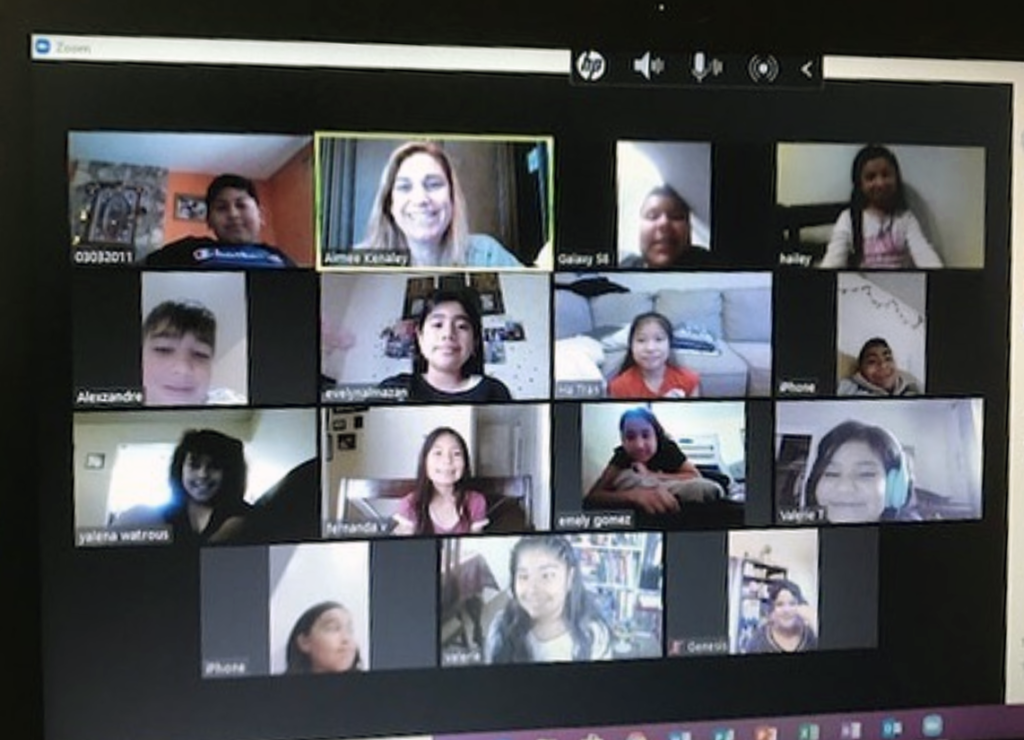 Photo: Aimee Kenaley/Instagram
Photo: Aimee Kenaley/InstagramBefore you can reach a student’s head to learn, you have to reach their heart and earn their trust. Educators should strive to be that support, especially during this pandemic and amid the civil unrest we are experiencing.
It’s likely that the trauma some students were experiencing before the pandemic struck may be escalating as a result of being forced to shelter at home. When school starts up again in the fall and on-site instruction resumes (even just a couple of days a week), students will need support in processing their emotions, learning to reconnect with their teachers and peers and catching up academically.
Pre-pandemic, nearly a third of teenagers had experienced a trauma or were in a chronic state of trauma such as abuse, homelessness, foster care, hunger, bullying, substance abuse in the home and even human trafficking.
Traumatized children who learn to thrive have someone in their life who encourages them and believes in their success.
All school leaders can educate teachers on a trauma-informed approach to learning. Here are seven key principles educators can implement now:
- Recognize your own feelings first. Just like on an airplane, you must put on your air mask before you can help others. That starts with acknowledging the grief and dislocation we are all experiencing. Take the self-care actions required so you can offer calm and empathy to students.
- Create a sense of stability with flexibility. In times of change and uncertainty, consistency with flexibility is important. Some teachers are setting appointments with their students in the evening so communication during the pandemic occurs regularly but on the student’s schedule.
- Listen and validate honestly. Adults often want to “fix” things, when a student just wants to be heard and supported. Instead of saying, “don’t feel bad” or “be strong,” acknowledging their feelings is the best way to earn trust and build a relationship.
- Encourage students to ask for help. Be there when they reach out for support but know when you need to refer the student to another professional. A crisis situation may require involvement and collaboration with child/adult protective services, a mental health response team, law enforcement or community mental health agencies. Let students know that you will support them throughout the process, and then follow through.
- Set appropriate expectations. Recognize each student’s abilities and circumstances or barriers before setting expectations. Be clear about what you expect and your confidence in the student’s ability to rise to the occasion. Notice and celebrate each success, no matter how small.
- Remind them they are not alone. Everyone could probably use that kind of reassurance these days. Students are not alone in their struggles even though they may sometimes feel they are. Research shows that when adversity feels like a shared experience, we cope better — not only emotionally, but neurologically. Creating opportunities for peer support allows students to help each other, sharing their strength and giving them a sense of purpose.
- Use a personalized approach. Students don’t all learn the same way, and they don’t deal with trauma the same way. Many of our students reach high school reading at a fifth-grade level. And many others have never received counseling to deal with stress and grief. It is important to develop a program for the student that deals with their social-emotional concerns while tailoring curriculum to their instructional needs.
Just because we’re not in the same room as our students, we still need to support their social-emotional health and help them cope.
School leaders who understand and integrate trauma-informed practices into teaching will find greater and long-term success for students. Isn’t that what it’s all about?
•••
Caprice Young is national superintendent of schools for Learn4Life, a network of nonprofit, public charter high schools that serves at-risk students by creating individualized educational programs.
The opinions in this commentary are those of the author. Commentaries published on EdSource represent diverse viewpoints about California’s public education systems. We welcome guest commentaries from teachers about how they are adapting to distance learning. If you would like to submit a commentary, please review our guidelines and contact us.
To get more reports like this one, click here to sign up for EdSource’s no-cost daily email on latest developments in education.


Comments (6)
Comments Policy
We welcome your comments. All comments are moderated for civility, relevance and other considerations. Click here for EdSource's Comments Policy.
Nadine Fairy 2 years ago2 years ago
This is so touching, especially the fact that the teacher’s daughter was there where you told the story. I love this. Teachers make a lot of impacts.
Rosie 3 years ago3 years ago
I’m with you on this. First of all, it is necessary to realize and accept your feelings, and only then with this calmness, you can influence your students. It’s more important than ever to care and hear each other, especially for teachers. Helpful reminder. Thanks!
Abigail Wenderson 3 years ago3 years ago
Such great tips, if these tips should seriously be taken by the teacher, it will be of great help to students
Junko Hosoi 3 years ago3 years ago
1. Class expectations
2. Get to know
3.How to use zoom
Bo Loney 3 years ago3 years ago
Why are many of our students reaching high school reading at a 5th grade level? How did this happen?
Pooja Josh 3 years ago3 years ago
Two things, I believe can work if we deliver this compassionately.
Give them a personal touch to the feelings.
Make them aware of the surroundings.
This is once in the lifetime situation and every one around is scared. So, it is important to handle the matter with delicacy and make them aware of the situation to face it.
Cheers, Very well written Ms. Young. 🙂